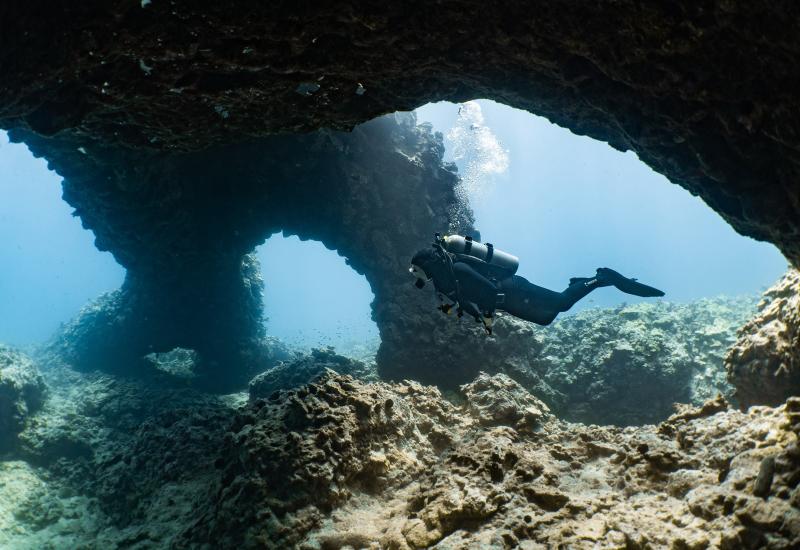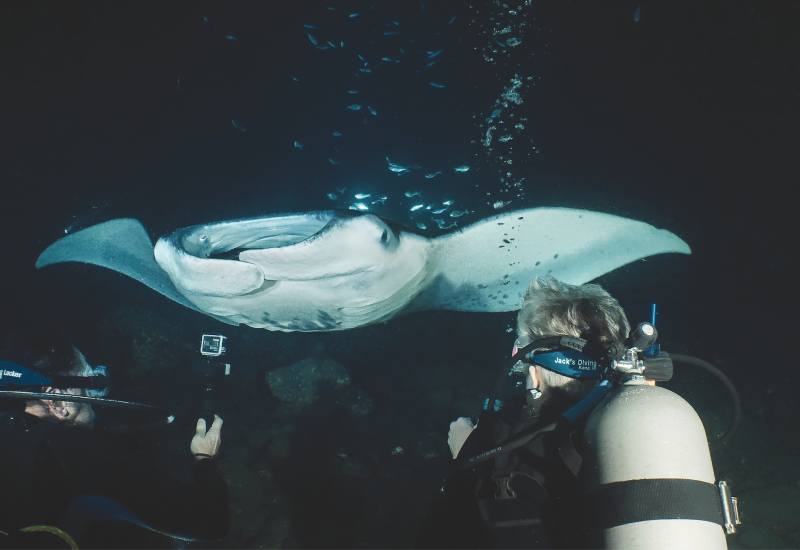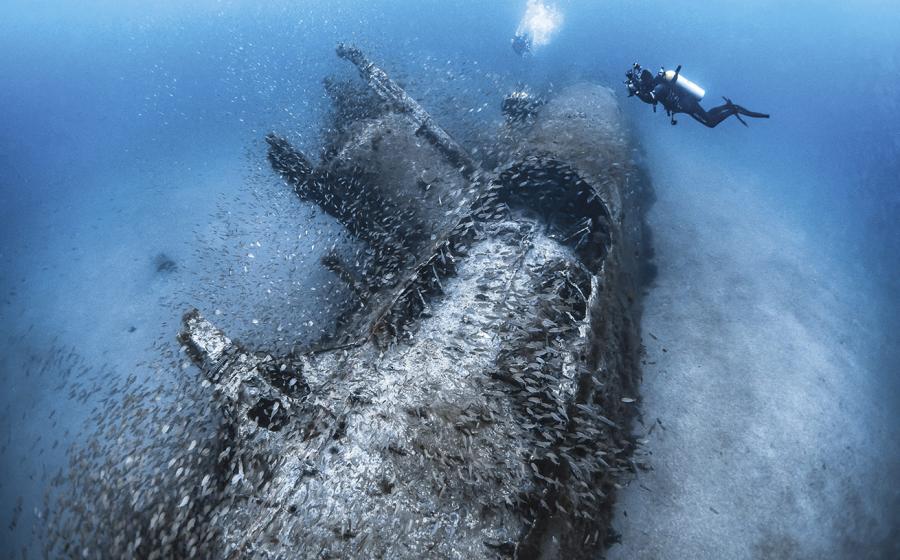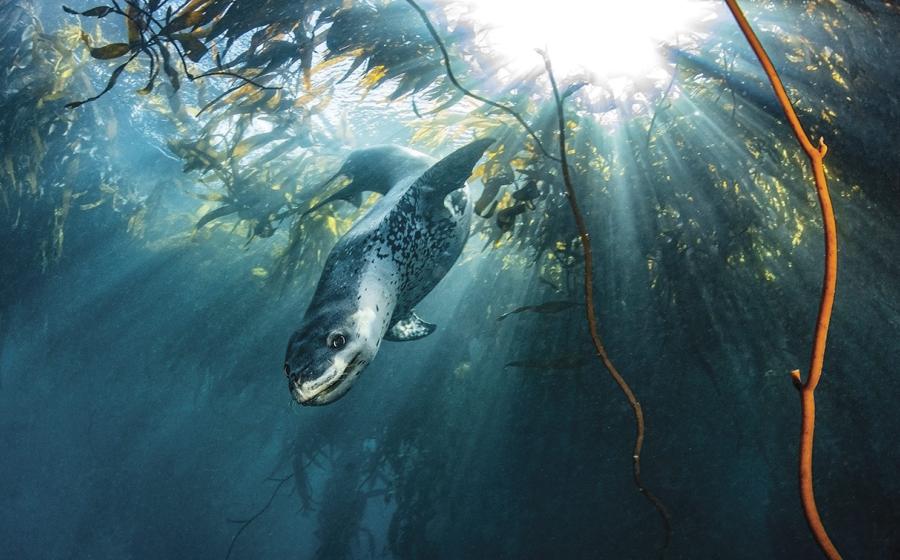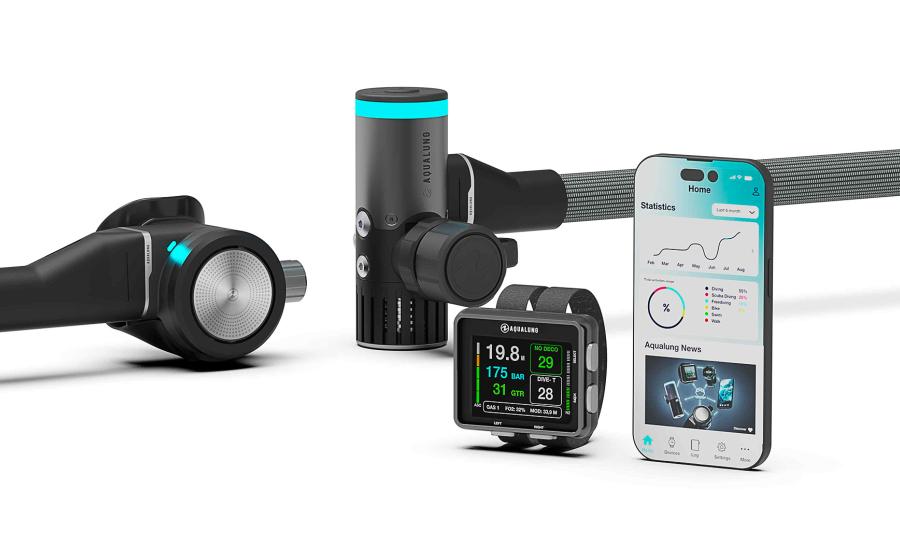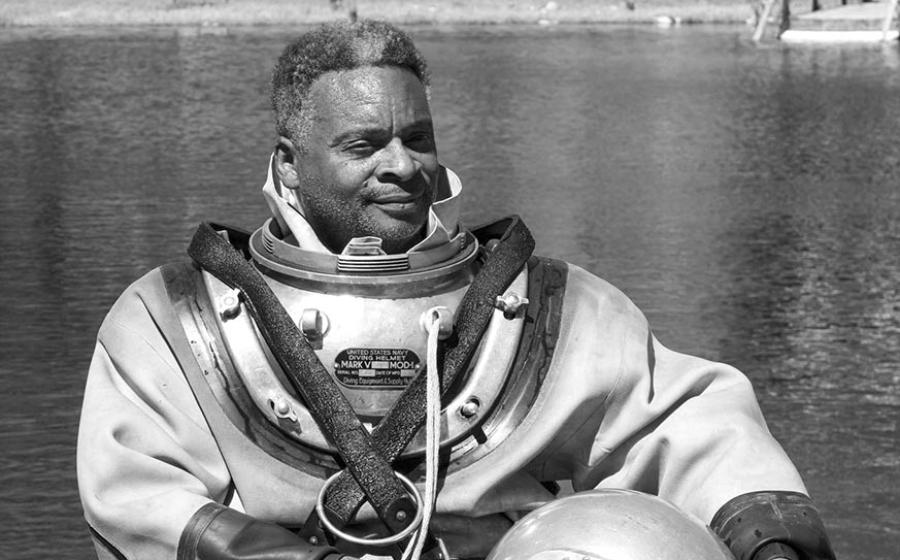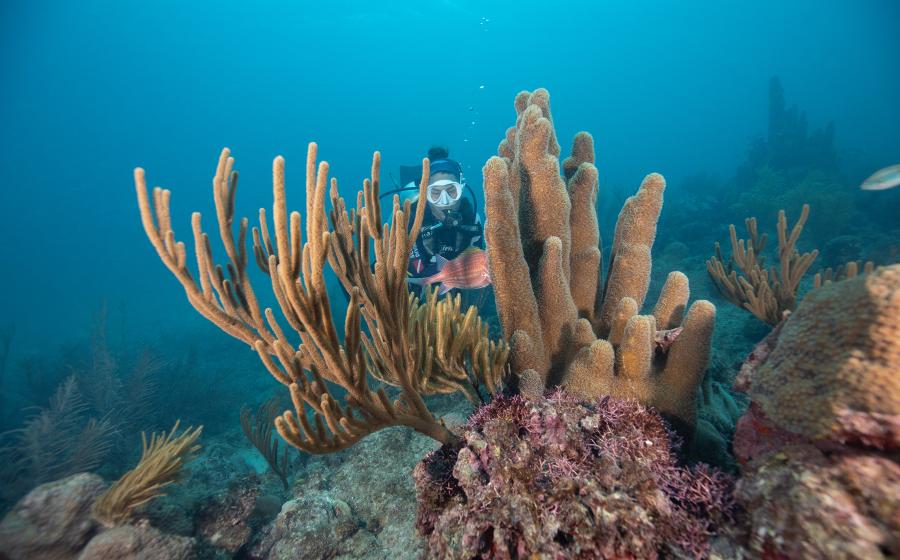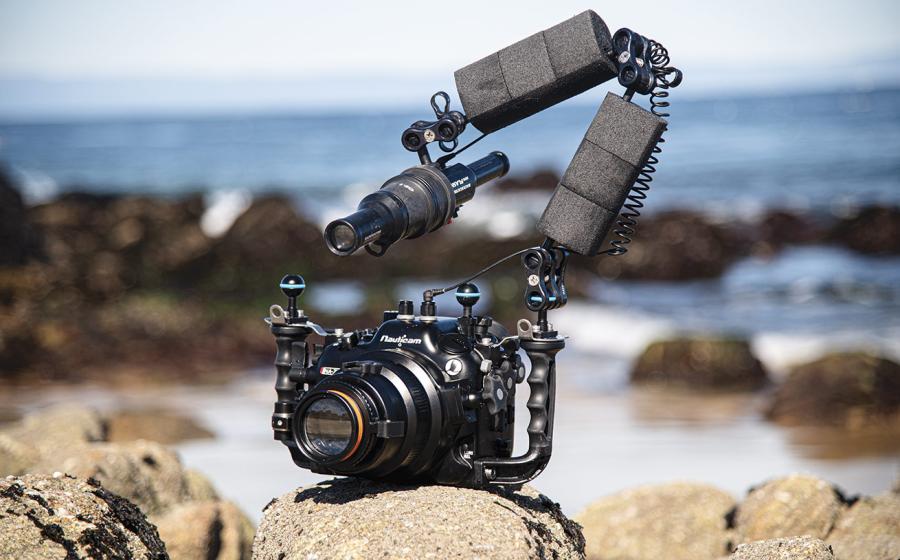Battle of the Blackwater Guides
I imagine this is what space would feel like if you ever found yourself aimlessly floating outside a spacecraft in orbit — like (spoiler alert!) Matt Damon in the final moments of The Martian – floating in complete darkness and wondering if you will make it. What’s that far-off squeaking sound? My spacecraft coming to retrieve me?
After a few moments, my eyes adjust to the inky blackness surrounding me and I realize I’m not in complete darkness. And that’s when I start to see them — translucent particles and shapes of all sizes floating past me. I’m not in space, but roughly 5 to 10 miles off the coast of Kona, Hawaii, tethered to a dive boat and drifting with it, as we search for tiny and sometimes large pelagic critters. Those distant squeals? A pod of dolphins on the hunt. The freaky aliens just millimeters from my mask? A larval lobster or octopus or maybe a siphonophore or pyrosome.
“There’s always something to see — a really freaky, weird, cool dive.” — Jeff Milisen
It’s really just as odd as it sounds, and that’s why it’s so easy for me to relate the experience to what I imagine space is like. It’s not recommended to new divers for a few reasons: the main reason being that it’s completely unlike any other dive. For starters, you are tethered to a line that is connected to the dive boat — think of it like one of the toddlers whose parents keep them on a leash. But instead of leading the way with an anxious parent tugging behind you to slow down, you are drifting through the black ocean with (at most) six other divers on the scavenger hunt of a lifetime. Armed with your dive light and in some cases your imagination, there is no shortage of marine life to encounter.
What It’s Like
To be completely honest, I was not overly excited about my first go. I had no idea what to expect other than a few YouTube videos I had watched, and I was extremely jet-lagged. That all changed the moment the dive briefing began.
Luckily, the enthusiasm of my dive guide, Jeff Milisen of Kona Honu Divers, who is a biologist and has been guiding this dive since 2011, was able to make me quickly forget how tired and nervous I was.
As Milisen begins his briefing at Honokohau Marina, two women approach and ask, “Is this where we meet for the manta dive?” Milisen quickly responds, “Nope, but we’re going to see some really weird stuff underwater tonight,” and then continues with a very thorough briefing, complete with pictures (from his very own little Black Book) of the animals we will certainly see (siphonophores), what would be awesome to see (larval octopuses) and what is extremely rare (pelagic sharks). Yes, there is a possibility of seeing sharks, but that percentage is estimated at about 2 percent.
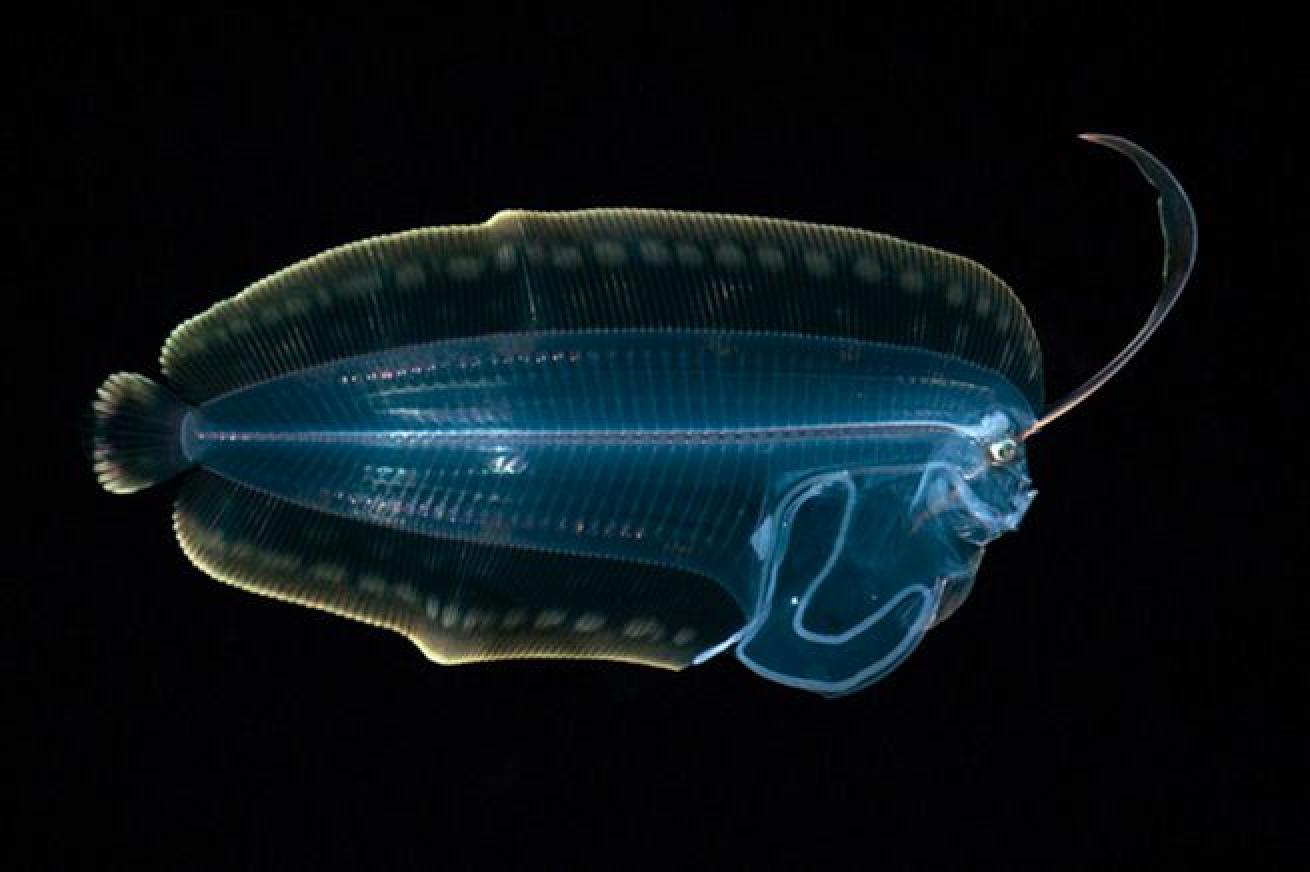
Jeff MilisenLarval flounder (Chascanopsetta prorigera)
Unlike adults, young flounder start off life with eyes on opposite sides of their heads like normal fish. Eventually, one of the eyes migrates over to the other side of the head. The side of the head that has the eyes helps determine what species the fish is. - Jeff Milisen
As we reach the spot to drop for the night, a rough 5 miles offshore, Milisen deploys a parachute into the water that attaches to the bow of the boat. This helps in keeping the boat stable as we drift through the water, tethered to the boat below. Then, one by one, the boat captain secures us to our tether and we back-roll in the water and descend. The tether only allows you to descend to around 50 feet, but you have the freedom to stay as shallow as you want. Each of us finds our sweet spot in the water column, and the hunt is on. It’s only a matter of seconds before I start seeing siphonophore after siphonophore floating past. Milisen, the only diver not tethered, swims dutifully around each of us pointing out the exciting critters he finds, a box jelly, larval flounder, larval shrimp, ctenophore after ctenophore, and so much more.
Related Reading: A Land-and-Sea Tour of Hawaii's Big Island
I experiment moving shallower in the water column, but am quickly met with surge in the shallow water and try to descend back down my line and take a few photos. But for me, this is where my dive becomes less enjoyable. I’ll admit, task loading got the best of me, and I begin to feel sick from adjusting my camera settings underwater. Luckily, it was almost the end of the dive. Back on the boat, I try my best to stare into the distance until we’re on our way back to the marina. The other divers gush about what a freaky-cool experience we just had, and I tell myself, “well, I’m not sure my stomach can handle that again.” Back at the harbor, I thank Milisen and the outstanding crew and try to get out of there as fast as possible without seeming rude. For me, shaking off seasickness is not always easy, so I head back to my hotel.
I’m scheduled to do a second blackwater dive later in the week, but I promptly cancel that. I plan to meet Milisen and his girlfriend over dinner to discuss the blackwater dive in detail. Over dinner, I learn that Milisen’s girlfriend, Sarah Matye, is the dive guide I would have been diving with the second time around. She’s shocked to hear that I’ve already canceled. Over pizza and beers, the two guides’ back-and-forth banter about who’s seen more pelagic sharks or who has been guiding this experience longer was starting to pique my interest. I’m not sure if it was the beers or the need to know who was the better guide, but Matye convinced me, and two days later, I find myself sitting in a classroom at Jack’s Diving Locker, listening to her version of the blackwater dive briefing.
During Matye’s briefing, she asks how many are first-timers, and the other five divers in the room all raise their hands. Suddenly, I feel more experienced, but it’s Matye who is the real expert, having guided more than 250 blackwater dives. She delivers the briefing with the same level of excitement as her first.
“It’s my most favorite, awesome dive and I just love it because you can always see something new on each dive,” she shares.
I ask around to find out why the other divers had signed up for this. Karl Kaszuba from Wyoming tells me, “I watched some YouTube videos and saw all the cool critters and had to add it to my bucket list.”
Despite a tropical storm that’s bearing down on Hawaii, we experience relatively calm seas in Kona. We motor to the same area a few miles offshore, but this time I’m not suffering from any seasickness.
And again, the underwater aliens arrive — squid zoom past and release their ink into the water, which strangely looks like blood at nighttime, and there’s no shortage of siphonophores. On this dive, I leave my camera on the boat and decide to just focus on the strange and shape-shifting translucent critters floating past. Just before the dive ends, Matye swims up to me excitedly pointing at a young reef octopus who has settled on her arm, apparently thinking it might have found its new home. She carefully removes the young cephalopod, wishing it well on its journey to find a real home on the reef.

Jeff MilisenSiphonophores may look superficially like a single organism when in fact they are a free swimming colony of them. They drift planktonically with tentacle-like structures splayed out in a web of stinging cells to capture the small pelagic animals that comprise its prey. When disturbed, the siphonophores we see quickly reel in their webs and move remarkably fast. -* Jeff Milisen*
Back on the boat, Matye describes this as a common occurrence among young octopuses, but a rare sighting on this dive. “They are just old enough to be on their own and looking for their new home in the ocean when in the middle of the night, they find us, a group of divers floating in the sea and think, "oh, this must be my home,” Matye explains.
On the ride back into the marina I feel an overwhelming sense of gratitude that I had the chance to experience this strange and unusual dive. There really is something to see the entire time you are underwater and no shortage of critters old and new. I get it now — I see how Milisen and Matye have become obsessed with this dive and document their every finding through photos, research and books. Both are biologists who share an undeniable passion for introducing this weird underwater world to anybody who dares to listen or show up for one of their weekly dives.
So in the end, who was the better guide? In all honesty, they both excel at what they do. Milisen and Mayte are both passionate about blackwater diving and both show a level of enthusiasm I haven’t witnessed in a dive briefing in a long time. You’d be doing yourself a favor to dive with either of them. Both Kona Honu Divers and Jack’s Diving Locker offer this dive on different days of the week, so you should have no problem fitting it into your schedule. Take my advice and sign up for this dive more than once. Like Milisen and Matye, you’ll fall in love at first siphonophore.
- Kona Honu Divers runs this dive every Wednesday and Friday and some Saturdays
- Jack’s Diving Locker runs this dive twice a week, on Tuesday or Thursday
Related Reading: Aaron’s Dive Shop, Oahu, Hawaii
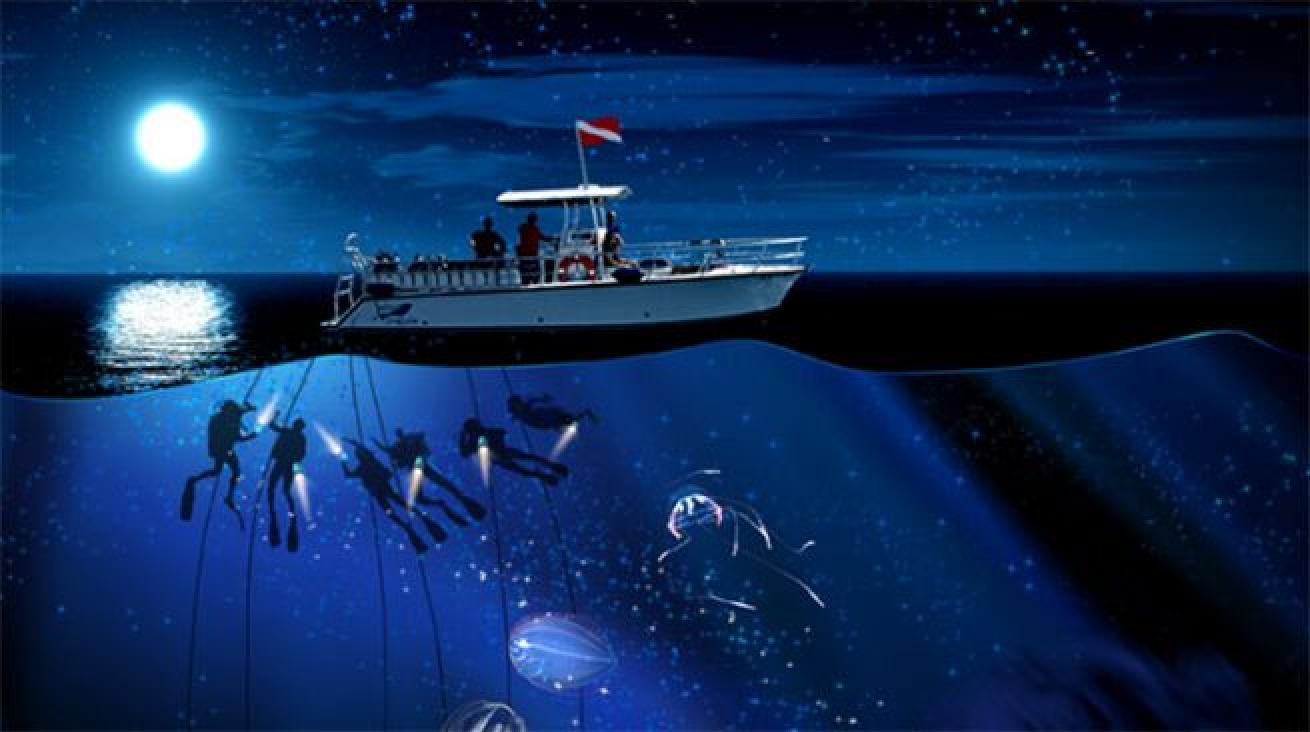
Jack's Diving LockerJack's Diving Locker also refers to the blackwater dive as the Pelagic Magic® dive. This diagram illustrates how the divers are situated in the water and tethered to the boat overhead.
Tips for Your First Blackwater Dive
- It’s not THAT dark: Yes, it is the darkest of any other night dive I’ve done, but you can always see the other divers since everyone has a light and is tethered to the same boat.
- Secure any loose objects: That means your light and camera if you plan to bring one. When the ocean floor is 5,000 feet away, you better believe if you drop something you are not getting it back.
- Bring a hood: If you are worried about something funky brushing up against your face, it can’t hurt to wear a hood.
- Bring a jacket: Since this dive takes off later in the evening, it’s wise to bring a jacket for when you are on the boat and those Hawaiian trade winds pick up.
- Relax: There’s no reason to be nervous and if you are, you can request to tether to the line at the back of the boat closest to the ladder. This allows you to be the last diver in the water and the first diver out of the water.
- Take seasickness medication: The potential for seasickness is a bit higher considering you do not have as many point of reference options on the boat or underwater.
What You’ll See
- Venus girdle (ctenophore)
- Net caster (siphonophore)
- Crustaceans
- Lanternfish
- Flying fish
- Purple backed flying squid
- Octopus
- Larval fishes
- Sharpear enope squids
- Mollusks
…and if you’re lucky, a pelagic seahorse! To see photos of these critters and read more about the history of blackwater diving, visit Milisen's website.
History of Blackwater Diving
Rumor has it that underwater photographers started the phenomenon back in the early 1980s. They heard about the incredible amounts of zooplankton and pelagic critters and had a need to photograph them. Christopher Newbert (Within a Rainbow Sea, 1984) is credited as one of the first blackwater divers. In his book, he describes going offshore, grabbing a line, and jumping overboard descending as deep as 150 feet. Alone. At night. At a time when there were many more sharks and at the height of Jaws fever.
It was unheard of, but from there it grew by word of mouth and locations such as Kona, Hawaii present the perfect backdrop. Sites over depths of 5,000 feet are considered to be the hot spots, and the Hawaiian Islands present a unique underwater landscape and ability to get out over deep water within a couple of miles of shore.
About the Guides
Jeff Milisen has a master’s degree from the University of Hawaii at Manoa on the biochemistry of cone snail venom. When he isn’t guiding blackwater dives for Kona Honu Divers, he is a biologist for the University of Hawaii at Manoa’s Hawaii Coral Reef Initiative. He is best known for his award winning underwater photography.
Sarah Matye holds a marine biology degree from UC Santa Cruz. She is a dive instructor for Jack’s Diving Locker and one of the leading blackwater guides in the world.
Matye and Milisen have a new adventure in the works; in late 2019, they will embark on a road trip around the United States to dive in every state with their dog and their undeniable love for the underwater world all packed up in a van. Follow along for one heck of an adventure.
To plan your trip to the Island of Hawaii, visit gohawaii.com



